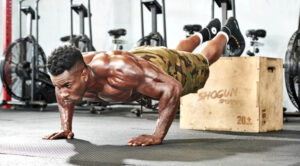The Push-up: a simple yet powerful exercise that requires no equipment and builds upper body strength. But what if you already have a decent amount of push-up strength? How can you push yourself further and maximize your existing abilities?
Pushups Exercises are beneficial and important for building upper body strength. They work the triceps, pectoral muscles, and shoulders. When done with proper form, they can also strengthen the lower back and core by engaging (pulling in) the abdominal muscles.
Push-up exercises are a fast and effective exercise for building strength. They can be done from virtually anywhere and don’t require any equipment.
Doing pushups every day can be effective if you’re looking for a consistent exercise routine to follow. You will likely notice gains in upper body strength if you do pushups regularly.
For the best results, continue to add variety to the types of pushups you do. You can also follow a “pushup challenge“ where you gradually increase the number of pushups each week. You can work up to doing 100 reps in two months.
Take your push-ups to the next level with this handy guide from Jeremy Ethier, where the NASM and FMS certified trainer and Kinesiology graduate explains how to unlock your push-up strength.
 This article delves into strategies to optimize your push-up routine, taking you from good to great.
This article delves into strategies to optimize your push-up routine, taking you from good to great.
Mastering Form: The Foundation of Progress
Before exploring advanced variations, ensure you have a solid foundation. A proper push-up form minimizes injury risk and maximizes muscle engagement:
- Plank Position: Start in a high plank with hands shoulder-width apart, fingers spread, core engaged, and a straight line from head to heels.
- Lowering: Lower your chest towards the ground while keeping elbows tucked close to the body (around a 45-degree angle) and back straight.
- Bottom Point: Briefly pause with your chest nearly touching the ground, maintaining a straight line throughout your body.
- Pushing Up: Press back to the starting position using your chest, shoulders, and triceps, keeping your core engaged and body rigid.
Beyond the Basics: Variations to Challenge Yourself
Once you’ve mastered the standard push-up, it’s time to explore variations that target different muscle groups and increase difficulty:
- Incline Push-Ups: Elevate your hands on a bench or sturdy surface, making the movement easier. Ideal for beginners or those building confidence.
- Decline Push-Ups: Place your feet on a bench or platform, making the push-up harder as your body weight shifts forward. Great for targeting the upper chest and shoulders.
- Diamond Push-Ups: Form a diamond shape with your thumb and index finger of each hand, bringing them closer than shoulder-width apart. This intensifies triceps engagement.
- Wide Push-Ups: Place your hands wider than shoulder-width apart, focusing on chest and outer chest muscles.
- Pike Push-Ups: Start in a high plank position with your hips high and body angled downwards. This variation emphasizes core strength and upper chest development.
Progressive Overload: Pushing Your Limits
To continue building strength, progressively overload your muscles. This means gradually increasing the difficulty of your workouts:
- Increase Reps and Sets: Gradually increase the number of repetitions you can perform in each set or the number of sets you complete in your workout. Aim for small increases (2-3 reps or 1 set) each week.
- Weighted Push-Ups: Add weight using a weighted vest or backpack filled with books. Start light and gradually increase the weight.
- Tempo Push-Ups: Slow down the movement by performing a controlled descent for 3-4 seconds and a powerful push-up for 1-2 seconds. This increases time under tension for your muscles.
Explosive Power: Plyometric Push-Ups
For those seeking explosive power, plyometric push-ups add a dynamic element:
- Clapping Push-Ups: Explode upwards from the bottom of the push-up, clapping your hands together in mid-air before landing softly back in the starting position.
- Jumping Push-Ups: After pressing back up to the starting position, jump explosively with a slight tuck before lowering back down into a push-up.
Advanced Techniques: Unlocking New Levels
For those who have mastered the variations above, explore these advanced techniques:
- Archer Push-Ups: Perform a push-up with one hand on the floor and the other extended in front of you, creating a straight line with your body. Alternate sides with each repetition.
- One-Legged Push-Ups: Increase core activation and stability by performing push-ups on one leg, keeping the other leg extended behind you.
- Handstand Push-Ups: This advanced variation requires significant strength and balance. Start with pike handstand push-ups before attempting full handstand push-ups.
Check Out Our List Of The Best Supplements For Building Muscle, Shredding Muscle, Recovery, And Great Health, and Wellness Products! Purchase ifbnewsfeed.org‘s apparels Here: ifbnewsfeed.org

 You will learn:
You will learn:
Table of Contents
- How To Unlock Your Push Up Strength
- 1 – Set Up
- 2 – Stabilisation
- 3 – Execution
- 4 – Modifications
How To Unlock Your Push Up Strength
1 – Set Up
Hand Placement
Two things should happen at the bottom of your push-up:
- Your forearms are on top of your wrists in a straight, vertical line
- Elbows tucked to 45 to 60-degree angle
This will help unlock many muscles that, in turn, can maximize your strength as you push, explains Ethier.

2 – Stabilisation
Improve your push-up strength by avoiding energy leaks. How?
- Push your knuckles down into the floor and spread your hands to create space between your fingers.
- Slide your shoulders down and away from your ears to activate the lats.
- Open your shoulder blades by pushing the floor away slightly.
- Tuck your tailbone to stabilize your hips and squeeze your thighs really hard to fully extend the leg.
3 – Execution
Use your back muscles to “pull” yourself from the floor. Your body will travel forward slightly to do so to keep your elbows over the wrists.
Once your reach the bottom position, push away from the floor all the way to the top to open the shoulder blades again.
Maintain a straight line between your head, shoulders, hips, and feet as you work through your reps.
4 – Modifications
If you can’t do more than 10 good push-ups in a row, you should think about modifying your training to build and increase your strength.
There are some good options:
As your strength improves, lower the amount of assistance you receive.

If you have mastered the push-up and can do 20+ reps clean, modifying the exercise to making it harder can be more effective for strength improvements. Try the following modifications:
- Slow down the reps
- Incorporate a 1-second pause at the bottom position
- Banded push-ups
Always Remember: Safety First
It’s crucial to prioritize proper form over pushing yourself beyond your limits. Stop if you experience pain, and consult a doctor or physical therapist for guidance if needed.
 Optimizing Your Push-Up Routine
Optimizing Your Push-Up Routine
Here are some additional tips to optimize your push-up routine:
- Warm-Up: Prepare your muscles with dynamic stretches like arm circles and shoulder rolls.
- Cool Down: Stretch your chest, shoulders, and triceps after your workout.
- Rest and Recovery: Allow your muscles adequate rest between workouts (48-72 hours) to repair and rebuild.
- Proper Nutrition: Fuel your body with a balanced diet rich in protein to support muscle growth and recovery.
- Track Your Progress: Monitor your reps, sets, and variations to chart your progress and stay motivated.
Wrapping Up : Pushing Your Push-Up Potential
With dedication and these strategic techniques, you can transform your push-up strength into a powerful tool for building a sculpted upper body. By incorporating advanced variations, progressive overload principles, and proper training practices, you’ll keep those challenges coming and witness continuous progress in your push-up prowess. So, get down on the ground, and get ready to push your limits!
More About Pull-Ups, Dips, And Push-Ups Contents
- Can Someone Possibly “Build Upper Body Muscles” With Pull-Ups, Dips And Push-Ups Only
- The Advantages/Disadvantages: “The Effects On The Body Of Doing Push-Ups” In A Daily Basis As A Workout Routine

- Get $200 With Your 1st Order Because Your Health Matters
- Best Supplements For Muscle Building, Strength & Champion Performance
- Best Supplements For Intense Energy, Performance & Endurance
For More News And Daily Updates, Follow IFBNewsfeed.Org on Facebook, Twitter, and Instagram. Comment, Like, And Share With Everyone Who May Need To Be Updated With The Most Recent Fitness/Bodybuilding/Powerlifting And CrossFit News.







